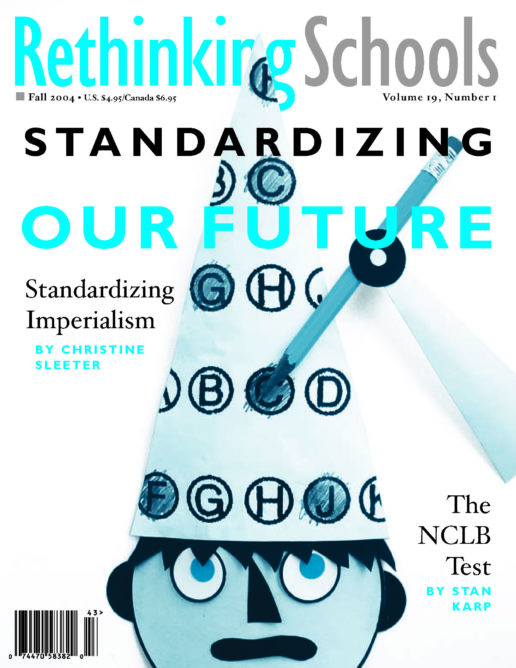Leaving Children Behind
I recently visited a grade school classroom that would make a great ad clip for the No Child Left Behind act (NCLB). Over the past few years, students in this classroom have scored high on standardized tests. The class runs like clockwork. Sitting in straight rows facing the teacher, busy children complete work in an orderly fashion, handing over finished papers and picking up new work from stacks on a long gray table with the precision of well-supervised assembly-line workers.
The teacher works with her red pen flashing, giving feedback so the children know exactly what they have accomplished and on what they need improvement. Children groan quietly to themselves when they get bad marks and give a soundless self-congratulatory thumbs-up when they get good marks.
This teacher cares about student success and calibrates learning activities with specific state standards. She posts names of children who have risen to the top in reading and math on a weekly basis and holds once-a-month certificate assemblies to honor student benchmarks. In the afternoon, the children participate in discussions, partner reading, read-alouds, and fact games.
The teacher says she carves out time for occasional field trips and such hands-on activities as salt-dough maps, shadow boxes, and, she hopes, an end-of-the-year play. But the bulk of time is spent on learning competencies and standards assessed by paper and pencil tests, since spring tests will also be paper and pencil.
Everything runs smoothly, the kids are bright-eyed, and their scores are high. This is a classroom of poster children for NCLB.
But the children seem stressed. They twitch and jiggle their knees with nervousness, and they glance often to the round wall clock. They are 9- and 10-year-olds hunched over pencil and paper as silent as mice, performing exactly as they have been asked on pre-algebra and sentence structure.
When they burst out of class for recess, lunch, and P.E. like wind-up toys, I ask a pair of boys how they like school.
They say it’s okay. They mention grades. They mention Accelerated Reader scores. They talk about how much work they do. They joke about getting yellow warning cards for behavior. But mostly they don’t want to talk because they need to run, wiggle, and roll.
A girl from the class tells me she has nothing bad to say about her current teacher, but her favorite teacher was last year.
“Why did you like her so much?” I ask.
“Because Mrs. X had rat bones and mummified chickens in an Egyptian shrine, and two snakes, and three turtles, and bean-bag chairs. We dissected worms and hatched trout. We journaled about the hatchlings for a long time, and on the second-to-last day of school, we freed them in a river. I got totally soaked,” she giggles.
“One day, Mrs. X found a really big brown spider in her garage, and she brought it to class. We kept it in a jar and then we voted to let the snakes eat it. She brought in an ostrich leg, and we dissected it. The skin on the leg looked how we thought dinosaur skin might look. The best was when she brought in owl pellets to dissect and we had a contest for who could find the most bones in their pellet. This one boy kept finding more bones—really tiny bones—really thin, but they were stuck to fur. He won.
“We went on lots of field trips, and Mrs. X took lots of pictures of us,” she continues. “She always developed them the very next day. By the end of the year, she had taken 11 pictures of me, and we made scrapbooks showing everything we had done.”
“What did you learn?” I persist.
“I learned about dinosaurs. We put on a paleontology musical in the spring. Mrs. X had made all the costumes herself. I was Diplodocus. We learned about endangered wolves and sponsored a wolf in a shelter. We learned how to ‘hook ’em, keep ’em, and punch ’em’ in writing. We had sled-dog-driver pen pals. We played ice soccer for P.E., and on Halloween, we had a bubble-gum-blowing contest. We had to eat through whipped cream to get to the bubble gum, and whoever blew a bubble first won.”
“What did you learn in that activity?” I ask smiling.
“Nothing, but it was fun. I guess I learned that the wetness in the whipped cream dissolves sugar so much that it’s hard to blow a bubble that holds together. Isn’t that science?”
The contrast between the perfect NCLB classroom and this classroom made me think. One of the dangers of NCLB is that all the focus on test scores means that little energy is left for imagination, creativity, intrinsic motivation, intuition, spontaneity, and children.
Teachers need to honor children as children. It is a gifted teacher who can guide children to explore the world meaningfully, to question powerfully, and to give back to their communities.
Micaela Rubalcava (Contact Me) is a professor of education at Truckee Meadows Community College in Reno, Nev. She has taught middle-school and high-school social studies.

